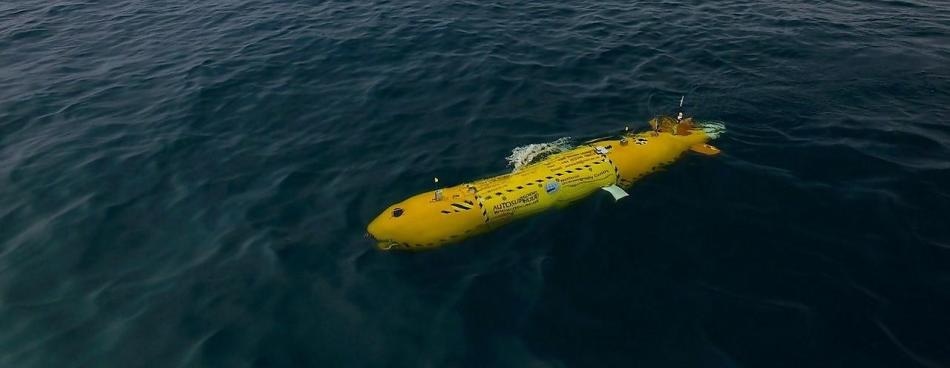May 13 2019
According to a new study headed by the University of Plymouth, artificial intelligence (AI) could help researchers cast new light on the type of species living on the ocean bed.
 During the dive, the AUV vehicle is flying 3 m high over the seabed at 2.2 knots (roughly 4 km per hour) and takes an image every second. (Image credit: University of Plymouth)
During the dive, the AUV vehicle is flying 3 m high over the seabed at 2.2 knots (roughly 4 km per hour) and takes an image every second. (Image credit: University of Plymouth)
Due to the rising threats faced by the marine environment, researchers badly require more information about what lives inhabit the seabed to guide conservation and biodiversity management.
Autonomous underwater vehicles (AUV) attached with the most modern cameras can now collect large quantities of data; however, a challenge is still posed by humans having to process it.
In a new research reported in Marine Ecology Progress Series, marine researchers and robotics experts tested the effectiveness of a computer vision (CV) system in possibly realizing that role.
They demonstrated that on average, it is approximately 80% accurate in recognizing different animals in images of the seabed; however, it can be up to 93% accurate for certain species if adequate data is used to train the algorithm.
According to the researchers, this shows that CV could soon be regularly applied to investigate marine animals and plants and result in a significant increase in data availability for conservation research and biodiversity management.
Autonomous vehicles are a vital tool for surveying large areas of the seabed deeper than 60m (the depth most divers can reach). But we are currently not able to manually analyze more than a fraction of that data. This research shows AI is a promising tool but our AI classifier would still be wrong one out of five times if it was used to identify animals in our images. This makes it an important step forward in dealing with the huge amounts of data being generated from the ocean floor and shows it can help speed up analysis when used for detecting some species. But we are not at the point of considering it a suitable complete replacement for humans at this stage.
Nils Piechaud, Study Lead Author and PhD Student, University of Plymouth
Most of our planet is deep sea, a vast area in which we have equally large knowledge gaps. With increasing pressures on the marine environment including climate change, it is imperative that we understand our oceans and the habitats and species found within them. In the age of robotic and autonomous vehicles, big data, and global open research, the development of AI tools with the potential to help speed up our acquisition of knowledge is an exciting and much-needed advance.
Dr Kerry Howell, Associate Professor in Marine Ecology, Principal Investigator, Deep Links project, University of Plymouth
The research was carried out as part of Deep Links, a research project funded by the Natural Environment Research Council, and headed by the University of Plymouth, together with Oxford University, British Geological Survey, and the Joint Nature Conservation Committee.
One of the UK’s national AUVs—Autosub6000, launched in May 2016—collected over 150,000 images in a single dive from approximately 1200 m beneath the ocean surface on the north-east side of Rockall Bank, in the North East Atlantic. Almost 1,200 of these images were manually studied, including 40,000 individuals of 110 various types of animals (morphospecies), majority of them seen only for a couple of times.
Scientists then employed Google’s Tensorflow, an open access library, to coach a pre-trained Convolutional Neural Network (CNN) to recognize individuals of different deep-sea morphospecies present in the AUV images. They subsequently evaluated how the CNN functioned when trained with various numbers of example images of animals, and various numbers of morphospecies to select from.
The accuracy of manual annotation by humans can lie in between 50% and 95%; however, this technique is slow and even experts are very inconsistent across time and research teams. This automated technique achieved up to 80% accuracy, nearing the performance of humans with apparent speed and benefit of reliability.
This is specifically true for certain morphospecies that functions very well with the algorithms. For instance, the model accurately recognizes one animal (a kind of xenophyophore) for 93% of the time.
The work does not support the replacement of manual annotation; however, it does show that marine biologists could be able to apply AI for particular tasks by cautiously evaluating the reliability of their predictions. This would significantly improve the potential of researchers to analyze their data.
The scientists state that the combination of specialist ecological knowledge with the high-tech AUV’s potential to study vast regions of the seabed, as well as the quick data processing capability of AI, could significantly accelerate deep-ocean exploration, and also the broader understanding of marine ecosystems.
Using robots and artificial intelligence to explore the deep-sea